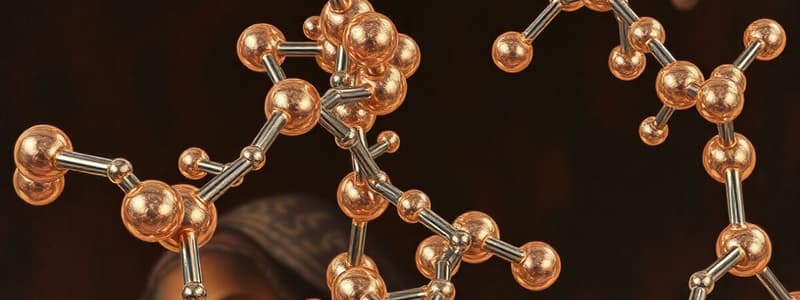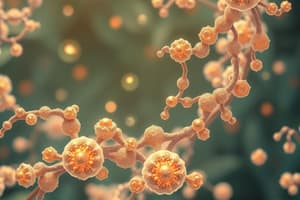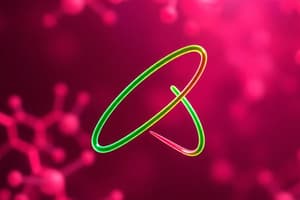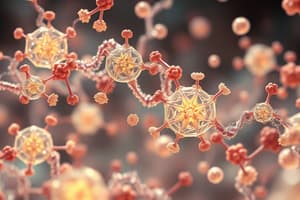Podcast
Questions and Answers
Which biomolecule is primarily responsible for energy storage in living organisms?
Which biomolecule is primarily responsible for energy storage in living organisms?
- Nucleic acids
- Proteins
- Lipids (correct)
- Carbohydrates
What are the two main categories of metabolism?
What are the two main categories of metabolism?
- Aerobic and Anaerobic
- Anabolism and Catabolism (correct)
- Photosynthesis and Cellular Respiration
- Fermentation and Glycolysis
What role do enzymes play in biochemical reactions?
What role do enzymes play in biochemical reactions?
- They increase the activation energy
- They lower the activation energy (correct)
- They are consumed in the reaction
- They act as substrates
Which process produces ATP through the breakdown of glucose?
Which process produces ATP through the breakdown of glucose?
Which of the following best describes the structure of DNA?
Which of the following best describes the structure of DNA?
Which biomolecule functions primarily in catalysis within cells?
Which biomolecule functions primarily in catalysis within cells?
What effect do temperature and pH have on enzyme activity?
What effect do temperature and pH have on enzyme activity?
Which stage of cellular respiration does not require oxygen?
Which stage of cellular respiration does not require oxygen?
What is the primary function of nucleic acids?
What is the primary function of nucleic acids?
What type of biomolecule primarily composes cell membranes?
What type of biomolecule primarily composes cell membranes?
What role does RNA play in protein synthesis?
What role does RNA play in protein synthesis?
Which of the following describes the tertiary structure of a protein?
Which of the following describes the tertiary structure of a protein?
What is the primary function of buffers in biological systems?
What is the primary function of buffers in biological systems?
How do side chains (R groups) of amino acids influence proteins?
How do side chains (R groups) of amino acids influence proteins?
What property of water allows it to act as an effective solvent for many substances?
What property of water allows it to act as an effective solvent for many substances?
What is the consequence of a change in enzyme shape?
What is the consequence of a change in enzyme shape?
Which of the following correctly defines quaternary structure?
Which of the following correctly defines quaternary structure?
What is the primary role of allosteric interactions in biochemical regulation?
What is the primary role of allosteric interactions in biochemical regulation?
What is the primary structural characteristic of RNA compared to DNA?
What is the primary structural characteristic of RNA compared to DNA?
What defines the primary structure of a protein?
What defines the primary structure of a protein?
Flashcards
What is Biochemistry?
What is Biochemistry?
The study of chemical processes within living organisms, including metabolism, enzyme catalysis, and the structure/function of biomolecules.
What are Biomolecules?
What are Biomolecules?
Essential organic molecules that make up living organisms, such as carbohydrates, lipids, proteins, and nucleic acids.
What are Carbohydrates?
What are Carbohydrates?
Sugars, starches, and cellulose, which provide energy and structural support.
What are Lipids?
What are Lipids?
Signup and view all the flashcards
What are Proteins?
What are Proteins?
Signup and view all the flashcards
What are Nucleic Acids?
What are Nucleic Acids?
Signup and view all the flashcards
What is Metabolism?
What is Metabolism?
Signup and view all the flashcards
What are Enzymes?
What are Enzymes?
Signup and view all the flashcards
What is Cellular Respiration?
What is Cellular Respiration?
Signup and view all the flashcards
What is DNA?
What is DNA?
Signup and view all the flashcards
What is RNA and its key role?
What is RNA and its key role?
Signup and view all the flashcards
What is the primary structure of a protein?
What is the primary structure of a protein?
Signup and view all the flashcards
What is secondary structure in proteins?
What is secondary structure in proteins?
Signup and view all the flashcards
What is tertiary structure in proteins?
What is tertiary structure in proteins?
Signup and view all the flashcards
What is quaternary structure in proteins?
What is quaternary structure in proteins?
Signup and view all the flashcards
How are biochemical reactions regulated?
How are biochemical reactions regulated?
Signup and view all the flashcards
Why is water important for biological processes?
Why is water important for biological processes?
Signup and view all the flashcards
What are amino acids and their importance?
What are amino acids and their importance?
Signup and view all the flashcards
What is pH and how does it affect biological systems?
What is pH and how does it affect biological systems?
Signup and view all the flashcards
How does hormonal signaling regulate biochemistry?
How does hormonal signaling regulate biochemistry?
Signup and view all the flashcards
Study Notes
Introduction to Biochemistry
- Biochemistry is the study of chemical processes within and relating to living organisms.
- It encompasses a wide range of topics, including metabolism, enzyme catalysis, and the structure and function of biomolecules.
- It's a foundational science for understanding biology and medicine.
Biomolecules
- Biomolecules are the essential organic molecules that make up living organisms.
- Major classes of biomolecules include:
- Carbohydrates: Provide energy and structural support. Examples include sugars, starches, and cellulose.
- Lipids: Store energy, form cell membranes, and act as hormones. Examples include fats, oils, and steroids.
- Proteins: Perform a vast array of functions including catalysis, transport, and structural support. Examples are enzymes and antibodies.
- Nucleic acids: Store and transmit genetic information. Examples are DNA and RNA.
- These molecules interact in complex ways to facilitate life processes.
Metabolism
- Metabolism refers to all the chemical reactions that occur in a living organism to maintain life.
- It can be categorized as:
- Catabolism: The breakdown of complex molecules into simpler ones, releasing energy.
- Anabolism: The synthesis of complex molecules from simpler ones, requiring energy.
- Metabolic pathways are a series of linked reactions that convert a substance into another. These pathways are often regulated to maintain homeostasis.
Enzymes
- Enzymes are biological catalysts, typically proteins, that speed up chemical reactions in living organisms without being consumed themselves.
- They lower the activation energy required for reactions to proceed.
- Enzyme activity is affected by factors like temperature, pH, and substrate concentration.
- Enzymes have specific active sites that bind substrates, facilitating the reaction. The specificity of the enzyme for its substrate is crucial.
Cellular Respiration
- Cellular respiration is the process by which cells convert glucose into ATP (adenosine triphosphate), the primary energy currency of cells.
- The process typically involves these stages: glycolysis, the Krebs cycle, and the electron transport chain.
- Aerobic respiration requires oxygen and produces significantly more ATP than anaerobic respiration.
Nucleic Acids: DNA and RNA
- DNA (deoxyribonucleic acid) carries the genetic instructions for building and maintaining an organism.
- It has a double-helix structure with complementary base pairing (A-T, G-C).
- RNA (ribonucleic acid) plays various roles in protein synthesis, including acting as a messenger between DNA and ribosomes.
- RNA has a single-stranded structure, with uracil (U) replacing thymine (T) in its base pairs.
Protein Structure and Function
- Protein structure is hierarchical, organized into primary, secondary, tertiary, and quaternary levels.
- The primary structure is the amino acid sequence.
- Secondary structure, like α-helices and β-sheets, are localized regular folding patterns.
- Tertiary structure is the overall 3D arrangement of the polypeptide chain.
- Quaternary structure describes the arrangement of multiple polypeptide chains in a protein.
- Protein conformation is critical to its function. Changes to shape can affect activity.
Regulation of Biochemical Reactions
- Biochemical reactions are often precisely controlled by various mechanisms to maintain homeostasis.
- Regulation can involve allosteric interactions, feedback inhibition, or covalent modifications of enzymes.
- Hormonal signalling is also a major player in modulating metabolic pathways in the body.
Water
- Water is the most abundant molecule in most living organisms.
- Its properties, such as polarity and ability to form hydrogen bonds, are key to many biochemical processes.
- The polar nature of water allows it to act as a solvent for many polar and ionic substances.
Amino Acids
- Amino acids are the building blocks of proteins.
- There are 20 common amino acids, each with a unique side chain (R group) with particular chemical properties influencing how the proteins fold.
- The side chains determine the overall function of the protein.
pH and Buffers
- pH is a measure of the hydrogen ion concentration in a solution.
- Biological systems maintain a relatively constant pH through buffers, which resist changes in pH.
- Enzymes have optimal pH ranges for activity, and deviations from this range can affect their function.
Studying That Suits You
Use AI to generate personalized quizzes and flashcards to suit your learning preferences.




